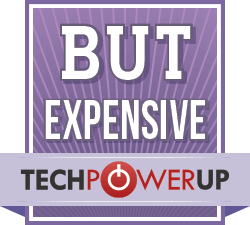 96
96
Zotac Zone Review - Amazing Screen and Great Gaming Performance
(96 Comments) »Value and Conclusion
- The Zotac Zone has an MSRP of $799/€849
- Praiseworthy gaming performance
- Excellent gaming performance at 12 W and below
- Gorgeous OLED screen
- Top notch build quality
- Hall Effect triggers and thumbsticks
- Brilliant D-pad
- Fully adjustable custom power profile
- Superb HDR
- Thumbsticks are very grippy
- Triggers are perfect for racing games
- Built-in kickstand
- Best rumble on a handheld, ever
- Adjustable triggers
- Attractive design
- Radial dials are handy
- Buggy software severely lacking in features
- MSRP is too high
- Only 16 GB of RAM and 512 GB of storage
- Poor battery life
- Quick Menu begs for more options
- No VRR
- Can't navigate Quick Menu with the D-pad
- Both the left and right click are mapped to the right trackpad, making mouse clicks flimsy and unresponsive
- Cannot remap mouse clicks
- Trackpads are too small
- Thumbsticks are very hard to replace
- Average speakers
- Might be too unwieldy for gamers with small hands
The Zotac Zone is a prime example of just how important the software is for PC gaming handhelds. The hardware here is near perfect. You've got the gorgeous screen, top-notch controls, attractive design, praiseworthy gaming performance that puts all other handhelds packing a Radeon 780M to shame, and impressive power scaling that makes the Zone usable at 12 W and lower.
On the other hand, the software is by far the weakest link in the whole chain. The One launcher is technically usable, stable, and runs fairly well. However, the lack of features, annoying bugs, and the poorly designed Quick Menu that somehow doesn't work with the D-pad leaves a sour taste in my mouth after weeks of testing.
Add only 16 GB of memory and 512 GB of storage, mix it up with the $800 asking price, and the resulting concoction isn't characterized by an especially appealing taste. Aside from being a miss with software, the Zone is also too expensive for what it offers to be an alluring alternative to the likes of ROG Ally, ROG Ally X, and Legion Go.
The OG ASUS Ally trumps the Zone in the software department with its breadth of features that make Armoury Crate burst at the seams, with frequent discounts allowing you to snag it for as low as $500 if you're patient. The ASUS Ally X sports the same price as the Zone, for which you're getting slower gaming performance but also 24 GB of memory, 1 TB of storage, a massive battery that runs circles around the Zone's battery life, and the same nifty collection of features courtesy of Armoury Crate.
The Lenovo Legion Go, on the other hand, can also be found for about $500 if you're patient, and while its software isn't as capable as ROG Ally's, the low price combined with a tad better software offering than what's found on the Zone is reason enough to pick it up over the Zone. Then there's the Steam Deck OLED that isn't in the same ballpark concerning performance. Valve's handheld, however, destroys the Zone, as well as every other Windows gaming handheld, when it comes to the software experience, and you're also getting an OLED screen that can match the one adorning the Zone in everything, including HDR.
If Zotac were to drop the price to $700 or $650, iron out the software kinks, and add some must-have features to the One launcher, I could see the Zone becoming a worthy option in the PC gaming handheld market. After all, the console has a few tricks up its sleeve, the most important ones being the gorgeous screen and fantastic gaming performance.
We've also got a couple of genuine and useful innovations here, such as the radial dials, adjustable triggers, and that amazing HDR-ready OLED screen. However, until we see a price drop, improvements on the software front, or both, the Zone will just stay a capable Windows gaming handheld burdened with high price and disappointing software.
Personally, I love using the Zotac Zone as long as I don't need extra buttons, secondary button functions, or some of the extra features, such as a way to quickly close down the game I'm playing, summon the keyboard, or the Afterburner performance overlay, snag a screenshot, enable FPS limiter, etc. In other words, I enjoy playing controller-friendly games on the Zone that support HDR and run well.
But the ASUS ROG Ally is still the way to go when I'm streaming games from my PC and playing games that can benefit from extra (controller or keyboard) inputs. It all boils down to the fact that the ROG Ally gives me a proper handheld Windows PC experience in games, while the Zone offers a kind of restricted experience reminiscent of a console handheld and not a full-fledged Windows PC, and to top it all off the thing's also buggy and considerably costlier.


On the other hand, the software is by far the weakest link in the whole chain. The One launcher is technically usable, stable, and runs fairly well. However, the lack of features, annoying bugs, and the poorly designed Quick Menu that somehow doesn't work with the D-pad leaves a sour taste in my mouth after weeks of testing.
Add only 16 GB of memory and 512 GB of storage, mix it up with the $800 asking price, and the resulting concoction isn't characterized by an especially appealing taste. Aside from being a miss with software, the Zone is also too expensive for what it offers to be an alluring alternative to the likes of ROG Ally, ROG Ally X, and Legion Go.
The OG ASUS Ally trumps the Zone in the software department with its breadth of features that make Armoury Crate burst at the seams, with frequent discounts allowing you to snag it for as low as $500 if you're patient. The ASUS Ally X sports the same price as the Zone, for which you're getting slower gaming performance but also 24 GB of memory, 1 TB of storage, a massive battery that runs circles around the Zone's battery life, and the same nifty collection of features courtesy of Armoury Crate.
The Lenovo Legion Go, on the other hand, can also be found for about $500 if you're patient, and while its software isn't as capable as ROG Ally's, the low price combined with a tad better software offering than what's found on the Zone is reason enough to pick it up over the Zone. Then there's the Steam Deck OLED that isn't in the same ballpark concerning performance. Valve's handheld, however, destroys the Zone, as well as every other Windows gaming handheld, when it comes to the software experience, and you're also getting an OLED screen that can match the one adorning the Zone in everything, including HDR.
If Zotac were to drop the price to $700 or $650, iron out the software kinks, and add some must-have features to the One launcher, I could see the Zone becoming a worthy option in the PC gaming handheld market. After all, the console has a few tricks up its sleeve, the most important ones being the gorgeous screen and fantastic gaming performance.
We've also got a couple of genuine and useful innovations here, such as the radial dials, adjustable triggers, and that amazing HDR-ready OLED screen. However, until we see a price drop, improvements on the software front, or both, the Zone will just stay a capable Windows gaming handheld burdened with high price and disappointing software.
Personally, I love using the Zotac Zone as long as I don't need extra buttons, secondary button functions, or some of the extra features, such as a way to quickly close down the game I'm playing, summon the keyboard, or the Afterburner performance overlay, snag a screenshot, enable FPS limiter, etc. In other words, I enjoy playing controller-friendly games on the Zone that support HDR and run well.
But the ASUS ROG Ally is still the way to go when I'm streaming games from my PC and playing games that can benefit from extra (controller or keyboard) inputs. It all boils down to the fact that the ROG Ally gives me a proper handheld Windows PC experience in games, while the Zone offers a kind of restricted experience reminiscent of a console handheld and not a full-fledged Windows PC, and to top it all off the thing's also buggy and considerably costlier.


Jul 14th, 2025 16:06 CDT
change timezone
Latest GPU Drivers
New Forum Posts
- Frametime spikes and stuttering after switching to AMD CPU? (573)
- AAF Optimus Modded Driver For Windows 10 & Windows 11 - Only for Realtek HDAUDIO Chips (578)
- i7 2860QM how to raise power limit? (21)
- AMD 7Ghz? This keeps popping up on my feeds! (6)
- Stupid things one has done with hardware (49)
- No offense, here are some things that bother me about your understanding of fans. (111)
- Choosing the right motherboard (5)
- Best motherboards for XP gaming (151)
- Which CPU to Choose for a 7900 XT? Ryzen 7 7700 or Ryzen 5 9600X? (43)
- Bent pins on an AM5 mobo, any way to test them and also find which ones were on the schematic? (6)
Popular Reviews
- Lexar NM1090 Pro 4 TB Review
- Our Visit to the Hunter Super Computer
- MSI GeForce RTX 5060 Gaming OC Review
- Fractal Design Epoch RGB TG Review
- NVIDIA GeForce RTX 5050 8 GB Review
- Corsair FRAME 5000D RS Review
- Sapphire Radeon RX 9060 XT Pulse OC 16 GB Review - An Excellent Choice
- Chieftec Iceberg 360 Review
- AMD Ryzen 7 9800X3D Review - The Best Gaming Processor
- Upcoming Hardware Launches 2025 (Updated May 2025)
TPU on YouTube
Controversial News Posts
- Intel's Core Ultra 7 265K and 265KF CPUs Dip Below $250 (288)
- Some Intel Nova Lake CPUs Rumored to Challenge AMD's 3D V-Cache in Desktop Gaming (140)
- AMD Radeon RX 9070 XT Gains 9% Performance at 1440p with Latest Driver, Beats RTX 5070 Ti (131)
- NVIDIA Launches GeForce RTX 5050 for Desktops and Laptops, Starts at $249 (122)
- NVIDIA GeForce RTX 5080 SUPER Could Feature 24 GB Memory, Increased Power Limits (115)
- Microsoft Partners with AMD for Next-gen Xbox Hardware (105)
- Intel "Nova Lake‑S" Series: Seven SKUs, Up to 52 Cores and 150 W TDP (100)
- NVIDIA DLSS Transformer Cuts VRAM Usage by 20% (97)